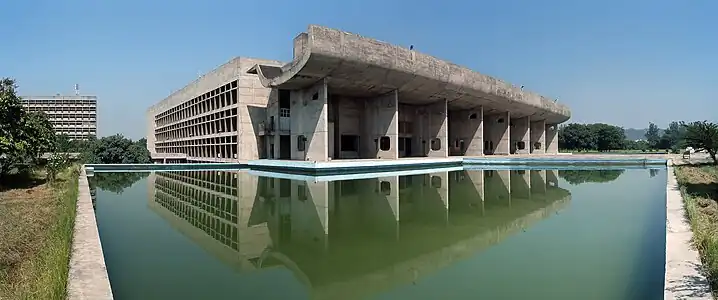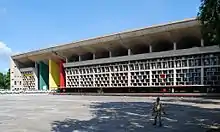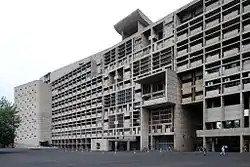Chandigarh Capitol Complex
Chandigarh Capitol Complex, located in sector-1 of Chandigarh city in India, is a government compound designed by the architect Le Corbusier[1] and is a UNESCO World Heritage Site.[2] It is spread over an area of around 100 acres and is a prime manifestation of Chandigarh's architecture. It comprises three buildings: the Palace of Assembly or Legislative Assembly, Secretariat Building and the High Court plus four monuments (Open Hand Monument, Geometric Hill, Tower of Shadows and the Martyrs Monument) and a lake.[3][4][5][6][7] It was added to the UNESCO World Heritage Site List in 2016 along with sixteen other works by Le Corbusier for its contribution to the development of modernist architecture.[8]
| UNESCO World Heritage Site | |
|---|---|
 Palace of Assembly at the Capitol Complex | |
| Official name | Complexe du Capitole |
| Location | Chandigarh, Chandigarh capital region, India |
| Part of | The Architectural Work of Le Corbusier, an Outstanding Contribution to the Modern Movement |
| Includes | Palace of Assembly, Secretariat Building, Punjab and Haryana High Court, Open Hand Monument |
| Criteria | Cultural: (i), (ii), (vi) |
| Reference | 1321rev-014 |
| Inscription | 2016 (40th Session) |
| Area | 66 ha (0.25 sq mi) |
| Buffer zone | 195 ha (0.75 sq mi) |
| Coordinates | 30°45′33″N 76°48′17″E |
 Location of Chandigarh Capitol Complex in India | |
Le Corbusier constructed the Tower of Shadows in such a way that not a single ray of sun enters it from any angle. The north side of this tower remains open because the sun never shines from this direction. Le Corbusier used the same principle for other Capitol Complex buildings as well.

 Secretariat Building
Secretariat Building The Palace of Assembly
The Palace of Assembly Entry gate to the Palace of Assembly
Entry gate to the Palace of Assembly
 The Tower of Shadows
The Tower of Shadows Geometric Hill
Geometric Hill 2nd International Yoga Day at Capitol Complex, 2016
2nd International Yoga Day at Capitol Complex, 2016
References
- "Le Corbusier's Capitol Complex a mess, in dire need of facelift". indianexpress.com. 10 March 2011. Archived from the original on 27 November 2013. Retrieved 18 July 2016.
- "Chandigarh's Capitol Complex is now a UNESCO heritage site". 18 July 2016. Archived from the original on 19 July 2016. Retrieved 18 July 2016.
- "Chandigarh's Capitol Complex is now a UNESCO heritage site: All you need to know". hindustantimes.com. 18 July 2016. Archived from the original on 19 July 2016. Retrieved 18 July 2016.
- "Capitol Complex, as Le Corbusier wanted it, remains incomplete – Indian Express". indianexpress.com. 19 June 2010. Archived from the original on 27 November 2013. Retrieved 18 July 2016.
- "The most planned city?". 9 February 2009. Archived from the original on 15 January 2021. Retrieved 20 February 2020.
- "UNESCO approves all 3 Indian nominations for heritage tag". intoday.in. Archived from the original on 19 July 2016. Retrieved 18 July 2016.
- "Four sites inscribed on UNESCO's World Heritage List". whc.unesco.org. UNESCO World Heritage Centre. 15 July 2016. Archived from the original on 16 July 2016. Retrieved 15 July 2016.
- "The Architectural Work of Le Corbusier, an Outstanding Contribution to the Modern Movement". UNESCO World Heritage Centre. United Nations Educational, Scientific, and Cultural Organization. Archived from the original on 24 November 2018. Retrieved 15 January 2022.
.jpg.webp)
